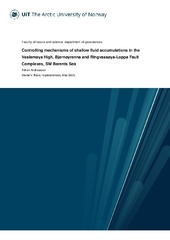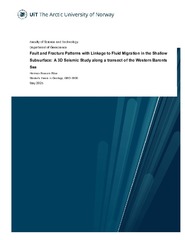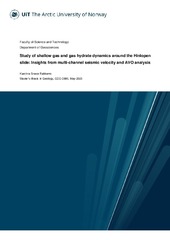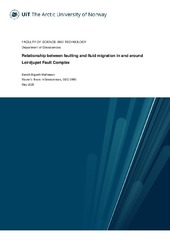Institutt for geovitenskap: Recent submissions
Now showing items 1-20 of 1121
-
Late Miocene speleothems show significant warming, temperate vegetation, and wildfires in Arctic Siberia
(Journal article; Tidsskriftartikkel; Peer reviewed, 2025-08-04)Climate driven northward boreal forest expansion into the tundra biome controlled by permafrost will play a major role in global emissions trajectories. Yet our limited understanding of the interplay between vegetation and permafrost makes predictions of changing boreal forest extent difficult. We analyse fossil pollen, stable carbon isotopes, and lignin and levoglucosan biomarkers from Tortonian ... -
Pre- and syn-orogenic sedimentation and volcanic activity in the internal domain of the southern Kaoko–Dom Feliciano–Gariep orogenic system
(Journal article; Tidsskriftartikkel; Peer reviewed, 2025-07-14)This work discusses the timing and sources for the pre- and syn-orogenic sedimentation in the southernmost internal domain of the Kaoko–Dom Feliciano–Gariep orogen. One sample from the Marmora Terrane (Gariep Belt, southern Namibia) yielded data suggesting a syn-orogenic origin, whereas data from two other samples suggest their pre-orogenic nature. Two volcanic rocks from the San Carlos Formation ... -
Ductile to Brittle Progression During Exhumation Controlled the Architecture of the Naukluft Nappe Complex, Namibia
(Journal article; Tidsskriftartikkel, 2025)Mountain belt architecture and evolution can be represented by frictional Coulomb wedges, a simplification that works well in the shallow deformation conditions of many foreland fold‐thrust belts. However, thin‐skinned fold‐thrust belts often occur in rocks that can deform ductily at low temperature. We demonstrate the importance of early ductile deformation in establishing the regional structure ... -
Decoupling short- and long-term methane seepage dynamics: high-resolution insights from Pyrgo spp. δ¹³C records at Woolsey Mound, Gulf of Mexico
(Journal article; Tidsskriftartikkel; Peer reviewed, 2025-07-24)Oceanic methane seepage plays a critical role in the global carbon cycle, yet reconstructing transient seepage variability remains challenging due to the complex interplay of environmental dynamics and biogeochemical processes. Here, we demonstrate that stable carbon isotopes from individual Miliolida foraminifera, particularly Pyrgo spp., offer a reliable high-resolution proxy for short-lived, ... -
Into the Blue: An ERC Synergy Grant Resolving Past Arctic Greenhouse Climate States
(Journal article; Tidsskriftartikkel; Peer reviewed, 2025-07-30)The Arctic Ocean is turning blue. Abrupt Arctic warming and amplification is driving rapid sea ice decline and irreversible deglaciation of Greenland. The already emerging, substantial consequences for the planet and society are intensifying and yet, model-based projections lack validatory consensus. To date, we cannot anticipate how a blue Arctic will respond to and amplify an increasingly warmer ... -
Deglaciation drove seawater infiltration and slowed submarine groundwater discharge
(Journal article; Tidsskriftartikkel; Peer reviewed, 2025-08-06)Submarine groundwater discharge—the flow of groundwater into the ocean—plays an important role in shaping coastal biogeochemical cycles. The absence of temporal constraints on offshore groundwater dynamics driven by proximal glacial loading hinders our assessment of how its circulation may vary in conceivable ice-free polar regions. Here we estimate residence times of saline groundwater at an active ... -
Diagenesis of hydrocarbon-seep carbonates: Common patterns, divergent pathways and conceptual pitfalls
(Journal article; Tidsskriftartikkel; Peer reviewed, 2025-07-04)Authigenic carbonates formed at marine hydrocarbon seeps are an important component of carbon cycling at continental margins. Ancient hydrocarbon-seep deposits serve as archives of the evolution of chemosynthesis-based ecosystems, past pore-water chemistry, and the tectonic architecture and geological history of their host sedimentary basins. However, while modern and ancient seep deposits share ... -
Western Greenland Ice Sheet-Land-Ocean Interactions: Near-Shore Dissolved Organic Carbon 14C Ages and Composition in Eastern Baffin Bay
(Journal article; Tidsskriftartikkel; Peer reviewed, 2025-07-11)Greenland's ongoing deglaciation and thawing permafrost, accompanied by an increase in ice sheet freshwater discharge and nutrient export, are significantly impacting the surrounding fjords and marine ecosystems. Understanding the geochemical linkages between ice, land, and marine environments is crucial for comprehending the effects of amplified cryosphere-biosphere interactions on marine ecosystems. ... -
Deep crustal deformation driven by reaction-induced weakening
(Journal article; Tidsskriftartikkel; Peer reviewed, 2025-07-11)Deep crustal shear zones, fundamental to the dynamics of terrestrial plate tectonics, exhibit complex processes of initiation and evolution that are yet to be comprehensively quantified across both long and short temporal scales. Conventionally, thermo–mechanical models posit that crustal rock behaviour is dominated by monomineralic aggregates undergoing processes like intracrystalline plastic ... -
Late Holocene history of Sefströmbreen in Ekmanfjorden, Svalbard
(Master thesis, 2025)There is limited documentation of complete surge cycles from Svalbard. Since the Little Ice Age, multiple surge-type glaciers in Svalbard have been undergoing continuous retreat. This has led to the formation of combined terrestrial and marine terminating margins, as well as newly exposed terrain, featuring glacial landforms such as crevasse-squeeze ridges, which are diagnostic landforms of surge-type ... -
Controlling mechanisms of shallow fluid accumulations in the Veslemøya High, Bjørnøyrenna and Ringvassøya-Loppa Fault Complexes, SW Barents Sea
(Master thesis, 2025)The southwest Barents Sea is a large sub-province within the Greater Barent Sea, an extensive epicontinental shelf that stretches from the northern coast of Norway, northward to Svalbard, and eastward to Franz Josef Land in Russia. This region has undergone a complex geological evolution, with phases of tectonic activity during the Paleozoic to Early Cenozoic. In the late Cenozoic, it was through ... -
Seasonal sea ice characterized the glacial Arctic-Atlantic gateway over the past 750,000 years
(Journal article; Tidsskriftartikkel; Peer reviewed, 2025-07-04)The past occurrence of an extreme ~1-kilometer–thick Arctic Ocean–Nordic Seas ice shelf has been inferred from submarine landscape features and geochemical records, although fundamental aspects of its characteristics, impacts, and timing remain highly debated. Here, we challenge this pan-Arctic glaciation hypothesis by investigating two sites from the Arctic-Atlantic gateway (AAG) and the Nordic ... -
Controls of sediment-bound and dissolved nutrient transport from a glacierised metasedimentary catchment in the high Arctic
(Journal article; Tidsskriftartikkel; Peer reviewed, 2025-06-16)Rapid warming in polar and alpine areas is causing significant glacier mass loss and resulting in increasing freshwater delivery to the oceans. Recent research indicates that higher meltwater water runoff is likely to increase solute and sediment transport, which will include nutrients, to downstream environments. This enhanced delivery may drive a negative feedback effect on atmospheric CO<sub>2</sub> ... -
Fault and Fracture Patterns with Linkage to Fluid Migration in the Shallow Subsurface: A 3D Seismic Study along a transect of the Western Barents Sea
(Master thesis, 2025)This thesis investigates shallow subsurface deformation patterns and their relationship to fluid migration and glacial processes in the southwestern Barents Sea. The study focuses on four key areas: Lyngenfjorden, Hammerfest Basin, Bjørnøyrenna, and Storfjordrenna. Using high-resolution P-Cable 3D seismic data and interpretation tools in Petrel, the objective was to identify faults, fractures, and ... -
The early-mid Quaternary development of the Bjørnøyrenna Trough Mouth Fan reconstructed from 3D-seismic data
(Master thesis, 2025)The early-mid Quaternary development of the Bjørnøyrenna Trough Mouth Fan is studied using 3D seismic data. The stratigraphy is divided into three seismic units; unit A (oldest) to C and is correlated to previously established stratigraphic frameworks in the Barents Sea. The reflection configuration and the geometry of the units, in combination with geophysical attribute analysis form the basis for ... -
3D-Seismic investigation of Fluid Flow and Faulting in the western margin of the SW Barents Sea, southern Sørvestsnaget Basin along the Senja Ridge
(Master thesis, 2025)The southwestern Barents Sea margin has attracted growing interest due to its hydrocarbon potential. However, the dynamics of its shallow subsurface fluid systems remain poorly understood. This thesis investigates fluid migration, faulting, and shallow gas accumulations within the southern Sørvestsnaget Basin adjacent to the Senja Ridge, using high-quality 3D seismic data (Carlsen3D) in combination ... -
Study of shallow gas and gas hydrate dynamics around the Hinlopen slide: Insights from multi-channel seismic velocity and AVO analysis
(Master thesis, 2025)The Hinlopen submarine slide located on the northern Svalbard margin is one of the largest submarine slides documented to date. The cause of the slide is associated with destabilizing factors like glacio-tectonic activity, isostacy, gas accumulation, gas hydrate dynamics, and rapid sediment loading in interglacial periods. Free gas accumulation within continental slope sediments is one of the most ... -
3D-seismic interpretation of fluid flow systems and faulting in the Sørvestsnaget Basin and the Veslemøy High, SW Barents Sea
(Master thesis, 2025)The southwestern Barents Sea encompasses a large part of the Norwegian Continental Shelf (NCS), expressing a complex geological history. The area is characterized by a series of rifting episodes from the Mesozoic and Paleozoic eras, along with more recent glacial impacts from the Late Cenozoic and the Quaternary period. The SW Barents Sea has experienced erosion and uplift, with large depocenters ... -
Relationship between faulting and fluid migration in and around Leirdjupet Fault Complex
(Master thesis, 2025)This study investigates the spatial relationship between ice-flow direction (inferred from Mega-Scale Glacial Lineations, MSGLs) and subvertical amplitude anomalies in the southwestern Barents Sea. The focus area is in and around the Leirdjupet Fault Complex, a tectonic boundary separating the Bjørnøya Basin from the Fingerdjupet Subbasin. Interpretation of a 3,757 km² 3D seismic cube, complemented ... -
Heavy potassium isotopes in carbonatites reveal oceanic crust subduction as the driver of deep carbon cycling
(Journal article; Tidsskriftartikkel; Peer reviewed, 2025-06-13)Carbon cycling between surface and mantle reservoirs is pivotal in fostering habitability of Earth. A critical yet poorly constrained parameter is whether crustal carbon can “survive” devolatilization processes that accompany slab subduction and therefore influence deep carbon budgets. Carbonatites provide a key record to address this important topic. Here, we present high-precision potassium isotope ...


 English
English norsk
norsk















